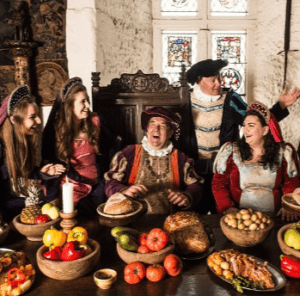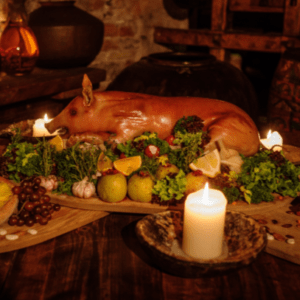 How about a little culinary time travel back to the 14th century? Back then, dining was a much different experience than it is today. Meals were grand events reserved for the upper crusts of society and involved elaborate preparations and rituals. Though the dishes may look foreign to our modern palates, medieval banquets gave us many customs still practiced.
How about a little culinary time travel back to the 14th century? Back then, dining was a much different experience than it is today. Meals were grand events reserved for the upper crusts of society and involved elaborate preparations and rituals. Though the dishes may look foreign to our modern palates, medieval banquets gave us many customs still practiced.
The Grand Events
Banquets in the Middle Ages were over-the-top affairs meant to impress guests and flaunt the host’s wealth and power. These shindigs were thrown for events like:
- Weddings
- Visiting diplomats
- Holiday celebrations
- Triumphal military returns
No expense was spared. The more exotic, rare, and sheer amount of food, the better.
For perspective, when England’s Richard II threw a banquet in 1387, the shopping list included:
- over 200 cows
- 100 pigs
- 1,000 sheep
- 13 swans
- 175 pigeons
- 270 rabbits
- 50 deer
- 40 geese
- 200 kids (young goats)
- 4 porpoises (sea mammals)
- 100 carp
- 12 seals
- sorella (a sweet wine) by the gallon
Now that’s a medieval feast!
The Rituals
These medieval meals weren’t just about the food. They followed strict protocols handed down over generations.
Some of the fancier rules included:
- Blessings by the church before and after eating
- Only eating with your right hand – the “clean” hand
- Bringing a knife and spoon yourself – forks didn’t show up until the 1500s
- Having a servant nearby to rinse fingers in rosewater between courses
- No elbows or dirty hands allowed on the table
Of course, tomorrow’s leftovers were donated. Waste not, want not!
Let’s not forget entertainment! Jugglers, musicians, dancers, acrobats, and more performed while attendees ate, drank, and made very merry.
The Cuisine
 Compared to today’s delicacies, much of what filled the tables and bellies back then might look peculiar. But they made it work with unique spices and techniques.
Compared to today’s delicacies, much of what filled the tables and bellies back then might look peculiar. But they made it work with unique spices and techniques.
Seasonings
Your typical salt and pepper were far too common for these grand affairs. Chefs were always on the search for more unique and rare nature foods to add flavor. They got creative with spices like:
- mace
- ginger
- nutmeg
- cardamom
- cinnamon
- saffron
- peppercorn
Herbs included parsley, sage, rosemary, and thyme. Lemons, oranges, pomegranates, added tart sweetness.
Various kinds of spirits brought sourness – the finer quality wine for the top tables and cheap beer or cider ones lower down.
Oh, and a whole lotta garlic!
Cooking Methods
Ovens, as we know them, didn’t exist. Most roasting and baking used fire pits and spits.
Boiling and poaching in pots, pans, and cauldrons suspended over the flames were common, too. Dairy products turned into sauces, added flavor.
And meals catered to religious rules against eating meat on Fridays, Lent, and feast days.
So, what exactly was on the menu? Let’s find out…
What They Ate: Dishes & Foods
Now for the fun part – the courses! Banquet diners ate quite differently than modern meals served in sequence. Their feasts focused on variety and creativity.
Served more “buffet-style,” attendees tried a little of many dishes over several hours. Then desserts and digestive aids followed to finish off the grand affair.
Here’s a tasting tour of what lords and ladies enjoyed at 14th-century banquets:
Hors d’Oeuvre – Appetizers
A little something to kick things off, like:
- Buttered Wafers – pastry circles
- Deviled Bones – fried bone marrow
- Pears in Wine Sauce
Potage – Soups
Thick, hearty soups to fill bellies, such as:
- Split Pea
- Leek
- Baked Apple
Roasts & Meats
The upper crust went all out, serving exotic meats along with familiar fare:
- Beef
- Pork
- Lamb
- Chicken
- Turkey
- Veal
- Venison (deer)
- Pheasant
- Peacock
- Swan
- Seal
- Porpoise
- Whale tongue
Take a walk on the wild side!
Pies, Pastries & Fritters
Carbs galore in the form of:
- Meat pies
- Fruit tarts
- Cheesecake
- Crispy fritters
- Custards and puddings
Vegetables & Legumes
Garden greens aplenty, like:
- Beans
- Leeks
- Onions
- Turnips
- Parsnips
- Cabbages
Often tossed in butter or cheese sauces. Yum!
Sweets & Desserts
A meal wasn’t complete without a little something sweet like:
- Sugar confections
- Fruits preserves
- Nuts
- Cheeseboard
And to aid that digestion…spiced Hippocras wine!
Simply medieval deliciousness.
The Fare of Peasants
Of course, we can’t discuss medieval cuisine without at least mentioning the lower classes, who seldom enjoyed such fancy banquets. The peasant fare consisted of simple foods they grew and raised themselves. Staples included dark bread, pottage (a thick stew), eggs, cheese, turnips, leeks, and the occasional bit of meat or fish. Some poached game from the lord’s forest lands when they dared. Though lacking spices and exotic ingredients, these simple dishes sustained the masses that supported the extravagant lifestyles of nobility through backbreaking work and taxation. Their tables may have had less variety, but they kept bellies full nonetheless.
Wrap-up
So, while the menus don’t resemble our modern palates, these medieval banquets laid the foundation for many food customs we still practice today at our own special events.
With such rare ingredients and quantities of food, 14th-century European feasts demonstrated affluence, reciprocity, and community.
Next time you attend a fancy dinner or celebration, raise your wine glass to toast the grand medieval banquets that started it all!

